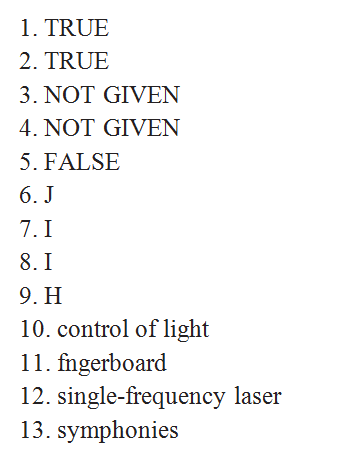Table of Contents
Passage
A In the blink of an eye, a wave of visible light completes a quadrillion oscillations, or cycles. That very large number presents both opportunities and a challenge. The opportunities promise numerous applications both inside and outside of laboratories. They go to the heart of our ability to measure frequencies and times with extremely high precision, a skill that scientists rely on for some of the best tests of laws of nature—and one that GPS systems, for instance, depend on. The challenge has centered on the impossibility of manipulating light with the techniques that work so well for electromagnetic waves of much lower frequencies, such as microwaves.
B Now, thanks to a decade of revolutionary advances in laser physics, researchers have at hand technologies that can unlock the latent potential that visible light’s high frequencies previously kept us from realizing. In particular, scientists have developed the tools to exploit a type of laser light known as an optical frequency comb. Like a versatile ruler of light with tens or hundreds of thousands of closely spaced “tick marks,” an optical frequency comb provides exquisitely precise measurements of light. Such a comb can form a bridge spanning the huge frequency gap from microwaves to visible light: very precise microwave measurements can, with an optical comb, produce equally exact data about light.
C Myriad applications are in the pipeline. Optical combs will enable a new generation of more precise atomic clocks, ultrasensitive chemical detectors and the means to control chemical reactions using lasers. The combs could greatly boost the sensitivity and range of lidar (light detection and ranging)—and also provide a vast increase in the number of signals traveling through optical fiber.

D Combs will greatly simplify the task of measuring optical frequencies with extremely high precision. In the 20th century such a measurement would have required a team of Ph.D.s running rooms full of single-frequency lasers. Today a graduate student can achieve similar results with a simple apparatus using optical frequency combs. The new optical atomic clocks also spring from this simplification. Much as a pendulum in a grandfather clock requires gears to record its swings and slowly turn the clock’s hands, an optical atomic clock uses an optical frequency comb to count the oscillations of light and convert them into a useful electronic signal. In just the past year, researchers have used optical combs to surpass the cesium-based atomic clocks that have been the best system available for decades.
E In some respects, the scene-changing advent of optical combs is similar to the leap forward that resulted from the invention of the oscilloscope about 100 years ago. That device heralded the modern age of electronics by allowing signals to be displayed directly, which facilitated development of everything from television to the iPhone. Light, however, oscillates 10,000 times faster than the speed of the fastest available oscilloscopes. With optical combs, the same capability to display the waveform is becoming available for light.
F Optical frequency comb applications require exquisite control of light across a broad spectrum of frequencies. This level of control has been available for radio waves for a long time but is only now becoming possible for light. An analogy to music helps in understanding the required level of control. Before the development of combs, lasers could produce a single color, like a single optical tone. They were akin to a violin with only one string and no fingerboard,capable of playing only one note (ignore for the moment that musical notes are much richer than pure tones). To play even a simple piece would require many different instruments, each painstakingly tuned. Each violin would require its own musician, just as every single-frequency laser requires its own operator.
G In contrast, one operator can use an optical comb to cover the entire optical spectrum, not merely like a pianist at a piano but like a keyboardist playing an electronic synthesizer that can be programmed to mimic any musical instrument or even an entire orchestra. Comb technology, in effect, enables symphonies of hundreds of thousands of pure optical tones.
H Optical frequency combs are generated by devices called mode-locked lasers, which create ultrashort pulses of light. To understand the important features of such pulses, begin by imagining the light wave of the other chief kind of laser, a continuous-wave (CW) laser. Ideally, such a wave would be an endless stream of perfectly regular oscillations (representing the light wave’s electric field), every wave crest and trough having the same amplitude and arriving at an unchanging rate. A pulse from a mode-locked laser, in contrast, is a short series of wave crests and troughs whose amplitude rises from zero to a maximum and then falls back to zero. The shortest pulses, with durations of less than 10 femtoseconds, contain just a few full oscillations of the light wave. The general outline of the pulse—its overall rise and fall—is called its envelope. One can think of the pulse as being like the earlier continuous wave (the “carrier wave”), with that wave’s amplitude multiplied by the changing height of the envelope.
I The carrier wave consists of light of one pure frequency. A plot of its spectrum would have a single spike at that frequency, representing the presence of that frequency alone. You might expect that the pulse you are imagining would also consist of light only at that frequency—after all, it is just the single-frequency carrier wave with its amplitudes changed but that is not how waves and spectra work. Instead the pulse is made up of light of many frequencies all traveling together. The frequencies form a small, continuous band centered on the carrier frequency. The shorter the pulse, the broader the spread of frequencies.
J Two additional features of the pulses emitted by mode-locked lasers are keys to the development of optical frequency combs. First, shifting the envelope a little relative to the carrier wave results in slightly different pulses. The peak of the pulse envelope may occur at the same time as a crest of the carrier, but it may also be shifted to any other stage of the oscillation. The amount of displacement is called the phase of the pulse. Second, mode-locked lasers emit trains of pulses at a very regular rate, called the repetition rate. The frequency spectrum of such a train of pulses does not form a continuum spread on each side of the carrier frequency but rather breaks into many discrete frequencies. Plotted, the spectrum looks like the teeth of a hair comb, spaced at precisely the laser’s repetition rate.
Questions
Questions 1-5 Do the following statements agree with the information given in Reading Passage 1? In boxes 1-5 on your answer sheet, write
TRUE if the sataement agrees with the information
FALSE if the statement contradicts the information
NOT GIVEN if there is no information on this
1 The number of loops that a fluctuation of optical light can achieve within a really short time is too large to believe.
2 A new device makes it possible for scientists to survey the frequencies across a wide range.
3 No other surveying instruments could do a better job than the optical combs do in the next few decades.
4 The story about the optical combs resembles to that of the oscilloscope.
5 The radar waves are still in the plight that it is not applicable to have a precise control over them.
Questions 6-9 The reading Passage has seven paragraphs A-J. Which paragraph contains the following information?
Write the correct letter A-J, in boxes 6-9 on your answer sheet. Emergency?
NB You may use the letter A-J more than once.
6 the subtle differences in the pulses caused by the little shifts of the envelope
7 a certain ratio relationship between the pulse and the range of the frequency
8 unexpected working mechanism for waves and spectra
9 a term used to depict the overview of a pulse
Questions 10-13 Complete the following summary of the paragraphs of Reading Passage, using no more than three words from the Reading Passage for each answer. Write your answers in boxes 10-13 on your answer sheet.
A key prerequisite for validates of the optical frequency combs is precise 10 ……………………. ranging from a wide selection of frequencies. To better understand what it means, a violin without 11 ……………………. can help describe the case. Likewise, specific manipulator is required for each 12 ……………………. while the availability of optical combs makes 13 ……………………. comprising several optical tones possible.
Answers



